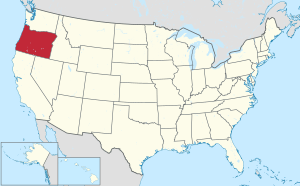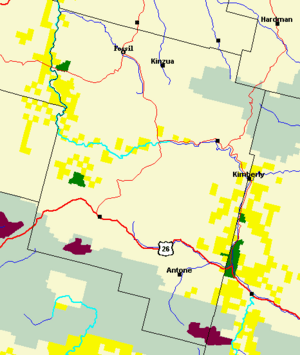Wheeler County, Oregon facts for kids
Quick facts for kids
Wheeler County
|
|
|---|---|

Wheeler County Courthouse in Fossil
|
|

Location within the U.S. state of Oregon
|
|
 Oregon's location within the U.S. |
|
| Country | |
| State | |
| Founded | February 17, 1899 |
| Named for | Henry H. Wheeler |
| Seat | Fossil |
| Largest city | Fossil |
| Area | |
| • Total | 1,715 sq mi (4,440 km2) |
| • Land | 1,715 sq mi (4,440 km2) |
| • Water | 0.5 sq mi (1 km2) 0.03%% |
| Population
(2020)
|
|
| • Total | 1,451 |
| • Estimate
(2023)
|
1,436 |
| • Density | 0.8/sq mi (0.3/km2) |
| Time zone | UTC−8 (Pacific) |
| • Summer (DST) | UTC−7 (PDT) |
| Congressional district | 2nd |
Wheeler County is a county in the U.S. state of Oregon. As of the 2020 census, the population was 1,451, making it Oregon's least populous county. It is named in honor of Henry H. Wheeler. an early settler who owned a farm near Mitchell. The county seat is Fossil, and Wheeler County is known for having Oregon's largest deposit of fossils.
Contents
History
Wheeler County was created on February 17, 1899, from parts of Grant, Gilliam, and Crook Counties. There have been no boundary changes since its creation. Fossil was designated the temporary county seat at the time of the county's creation. In 1900 there was an election to determine the permanent county seat between the three towns of the county, which ended with Fossil winning the election.
Henry H. Wheeler (born September 7, 1826, Erie County, Pennsylvania - died March 26, 1915, Mitchell, Oregon) arrived in Oregon in 1862, moved around, and settled near Mitchell, Oregon. He married Dorcas L. Monroe on December 19, 1875.
Geography
According to the United States Census Bureau, the county has a total area of 1,715 square miles (4,440 km2), of which 1,715 square miles (4,440 km2) is land and 0.5 square miles (1.3 km2) (0.03%) is water.
Adjacent counties
- Gilliam County - north
- Morrow County - northeast
- Grant County - east
- Crook County - south
- Jefferson County - west
- Wasco County - northwest
National Protected Areas
- John Day Fossil Beds National Monument (part)
- Ochoco National Forest (part)
- Umatilla National Forest (part)
Major highway
- U.S. Route 26
- Oregon Route 19
Demographics
| Historical population | |||
|---|---|---|---|
| Census | Pop. | %± | |
| 1900 | 2,443 | — | |
| 1910 | 2,484 | 1.7% | |
| 1920 | 2,791 | 12.4% | |
| 1930 | 2,799 | 0.3% | |
| 1940 | 2,974 | 6.3% | |
| 1950 | 3,313 | 11.4% | |
| 1960 | 2,722 | −17.8% | |
| 1970 | 1,849 | −32.1% | |
| 1980 | 1,513 | −18.2% | |
| 1990 | 1,396 | −7.7% | |
| 2000 | 1,547 | 10.8% | |
| 2010 | 1,441 | −6.9% | |
| 2020 | 1,451 | 0.7% | |
| 2023 (est.) | 1,436 | −0.3% | |
| U.S. Decennial Census 1790–1960 1900–1990 1990–2000 2010–2019 |
|||
2010 census
As of the 2010 census, there were 1,441 people, 651 households, and 408 families living in the county. The population density was 0.8 inhabitants per square mile (0.31/km2). There were 895 housing units at an average density of 0.5 units per square mile (0.19 units/km2). The racial makeup of the county was 92.4% white, 1.2% American Indian, 0.6% Asian, 0.1% Pacific islander, 2.6% from other races, and 3.1% from two or more races. Those of Hispanic or Latino origin made up 4.3% of the population. In terms of ancestry, 28.4% were German, 24.0% were English, 20.0% were Irish, and 8.4% were American.
Of the 651 households, 20.3% had children under the age of 18 living with them, 51.9% were married couples living together, 7.2% had a female householder with no husband present, 37.3% were non-families, and 32.4% of all households were made up of individuals. The average household size was 2.18 and the average family size was 2.70. The median age was 53.0 years.
The median income for a household in the county was $33,403 and the median income for a family was $43,167. Males had a median income of $36,328 versus $31,792 for females. The per capita income for the county was $20,598. About 9.1% of families and 11.4% of the population were below the poverty line, including 12.0% of those under age 18 and 5.7% of those age 65 or over.
Economy
Principal industries in this county are agriculture, livestock, and lumber.
Communities
Cities
Unincorporated communities
- Clarno
- Richmond
- Service Creek
- Spoos Mill
- Twickenham
- Waterman
- City of Wheeler (had a post office Aug 1890-Sept 1895)
- Winlock
Former communities
Education
School districts include:
- Condon School District 25J
- Dayville School District 16J
- Fossil School District 21J
- Mitchell School District 55
- Spray School District 1
The county is not a part of a community college district.
See also
 In Spanish: Condado de Wheeler (Oregón) para niños
In Spanish: Condado de Wheeler (Oregón) para niños


